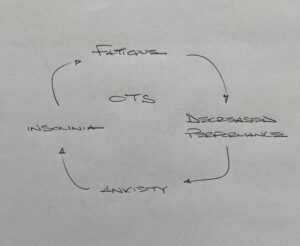By SwimSwam Contributors on SwimSwam

This article was originally published on June 21, 2021.
During last week’s U.S. Olympic Trials, news came to light that four-time Olympic medalist Simone Manuel had been diagnosed with Overtraining Syndrome (OTS) around early March, and ended up taking an extended three-week break out of the pool in April.
Manuel spoke openly about her experience with OTS after failing to advance to the final of the women’s 100 freestyle, the event in which she won 2016 Olympic gold and back-to-back World Championship titles in 2017 and 2019.
Manuel ended up qualifying for the U.S. Olympic team in the 50 free on Sunday night. After that victory, the 24-year-old mentioned that she wants to be a voice for other swimmers that have dealt with similar symptoms.
Below, find an overview of exactly what OTS is, and the resulting symptoms, from Shawn Trokhan, M.D.
Disclaimer: This is not medical advice.
I’ve gotten a lot of questions in and out of the office recently about Simone Manuel and Overtraining Syndrome (OTS). And so I thought it would be helpful to give a quick overview of what happened, and more importantly give insight into what to look for in young athletes as they work hard to achieve success at different levels.
I think the most important thing to discuss from the outset is “What is a Syndrome?” A syndrome is simply “a group of symptoms which consistently occur together, or a condition characterized by a set of associated symptoms.” A syndrome is not a disease per se. A syndrome is not necessarily testable with simple bloodwork or an x ray. It is just a group of symptoms commonly seen in a situation, many times affecting different body systems. As well, many times one symptom in a syndrome can lead a patient down a path to the other symptoms.
 In this situation, Overtraining Syndrome is a constellation of symptoms commonly seen with, simply enough, overtraining. These symptoms include fatigue, faster heart rate even well after practice, and sore muscles, which can lead to decreased performance. And here is where things get complicated. These symptoms, in an elite athlete with lots of the line, can lead to other symptoms. Decreased performance can lead to depression, loss of motivation, and anxiety. Which can lead to insomnia, leading to irritability, agitation, and weight loss. Which can lead back to fatigue and decreased performance. It’s an extraordinarily tough cycle, and it becomes even more difficult with large, looming deadlines like the Olympic Trials on the horizon.
In this situation, Overtraining Syndrome is a constellation of symptoms commonly seen with, simply enough, overtraining. These symptoms include fatigue, faster heart rate even well after practice, and sore muscles, which can lead to decreased performance. And here is where things get complicated. These symptoms, in an elite athlete with lots of the line, can lead to other symptoms. Decreased performance can lead to depression, loss of motivation, and anxiety. Which can lead to insomnia, leading to irritability, agitation, and weight loss. Which can lead back to fatigue and decreased performance. It’s an extraordinarily tough cycle, and it becomes even more difficult with large, looming deadlines like the Olympic Trials on the horizon.
We have a saying in my office. “Sometimes the fastest way to move forward is to Stop.” And so while I am not her treating physician, it sounds like Simone made a tough but necessary choice. She stopped. She broke the cycle, rested, recalibrated, and came back.
Overtraining Syndrome is something that can be seen at many levels of swimming. And I think we are all lucky to have had an athlete like Simone bring it to our attention, but more importantly, come out the other side successfully.
ABOUT SHAWN TROKHAN
Shawn Trokhan, M.D. graduated from Princeton University where he was an Ivy League Champion swimmer, NCAA All-America award winner three times, and Olympic Trials qualifier. He studied medicine at the Case School of Medicine and the Cleveland Clinic in Cleveland Ohio, then completed his orthopaedic surgery residency at Mount Sinai in New York City. Dr. Trokhan is currently in private practice in northern NJ. You can read more about him at www.Trokhan.com.
SwimSwam: What Is Overtraining Syndrome – And How Does It Affect Athletes?


















You must be logged in to post a comment Login